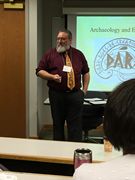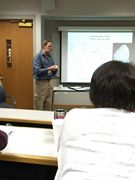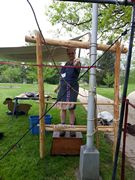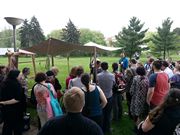International Congress on Medieval Studies - Kalamazoo May 2015
At the 50th anniversary Congress DARC stepped up its participation by hosting a sponsored paper session, and a demonstration.
The call for sessions was answered with:
Archaeology & Experiment: Moving beyond the artifacts
Archaeological sessions tend to focus on presentation of results from excavations or preliminary analysis. Experimental archaeology moves beyond the artifacts,
allowing researchers to examine the underlying question of "how" related to artifact finds. Ideally, experiments can provide a preliminary answer to the question
"Does this theory of how it was done actually work". A keystone of experimental archaeology (and a differentiator from reenactment/recreation) is that it follows
the scientific method of question, setup, and result - whether that result is positive or negative. Presentations in this session will be expected to review all
three key elements in the discussion of their paper. Papers submitted for these sessions would be good candidates for publication in the EXARC Journal.
The two papers presented in that session were:
New Speculative Reconstructions of Viking Age Women's Clothing informed by finds from Revninge, Hårby, and Lejre by V. M. Roberts
Evidence for the overall look of clothing in the Viking Age is inconclusive. Recently, three figurines have been discovered which shed substantial light on the
silhouette, layering, and structure. These figurines do not provide enough detail for confident reconstructions; however, by working through some possibilities
on cloth, and comparing the results to these images and others, as well as to literary and archaeological data, it is possible to improve our understanding of the
dress culture. These new finds reveal surprising details about the upper chest and arm regions. Each provides a previously rare front-view, giving new context for
the vertical lines seen regularly in side-views. As a group, the outfits are very different from one another, providing a useful opportunity to recognize
consistencies across divergent costumes. Particular attention will be paid to silhouette, construction, and outer garments.
"Turf to Tools": Ore to the Rhynie Man Axe by Darrell Markewitz
The 'Turf to Tools' project undertaken in August of 2014 at the Scottish Sculpture Workshop bought together an unusual team of interested individuals. The outline
of the project was to investigate nearby natural materials, utilizing regional ancient process, with the intent of replicating a specific local 'Pictish Late Iron
Age' object. Iron was to be smelted using the distinctive 'Macaulayite' ore. The prototypes for the furnace were those uncovered at the Cuduthel site in nearby
Inverness. The object was the axe seen on the Rhynie Man picture stone. As with any experimental archaeology, the end results of Turf to Tools are a blend of rewards
and failures, and surprising directions for future research.
 |
 |
| |
| Neil's Introduction |
Darrell's Lecture |
Archaeology Unearthed: Hands on history demonstrations
Many literary scholars see history in isolation from the artifacts and processes of the period under study. Adding a demonstration of techniques and
technologies that have been understood or reproduced using Experimental Archaeological methods allows attendees of ICMS to enhance their appreciation of the
underlying artifacts and technologies. This session will showcase 2-4 technologies allowing session attendees to circulate among the demonstrations and discuss
them with the presenters. The AVISTA Iron smelt in 2013 was a good example of this class of demonstration. Note that this session would be expected to be presented
outside and would thus not require a room, although they should occur during a normal session time frame. The afternoon session time would be optimal allowing these
demonstrations to extend into the pre-dinner break.
This demonstration was set up with three stations. The stations spoke in turn.
Sheep to Shoulders: The Steps in Textile Production in the Viking Era
Karen Davidson walked attendees though each step of textile production. Combing wool, dyeing it, spinning it to thread. Creating skeins, and finally warping and weaving
on a warp weighted loom.
An Experimental Reconstruction of the Ribe Bead Making Furnace
A reconstructed furnace based on the archaeology of Ribe was demonstrated with a discussion on the known archaeology, the experimental sequences we have executed,
as well as the process for creating a bead in a furnace of this type.
'The Aristotle Furnace' - An experimental iron to steel re-melting furnace
The Aristotle is a small sized re-melting furnace based on historic descriptions in Aristotle's "Meterologica' and later Ole Evenstad's descriptions in the 1780's.
This working system was introduced by Skip Williams, and was further developed by the 'Early Iron' group over a workshop session in 2008 - 2009. Built of clay at
roughly 10 cm diameter and 30 cm tall, this furnace will covert almost any iron material into a 500 - 750 gram puck of high carbon bloomery 'steel' in roughly 30
minutes. This demonstration will cover the historical context of this type of furnace, and how it is built, and illustrate an operation cycle.
 |
 |
 |
 |
| Darrell Preparing |
Karen Preparing |
Karen Lecturing |
Large Crowd |
 |
| | |
| Loom discussion |
 Dark Ages Re-Creation Company
Dark Ages Re-Creation Company







